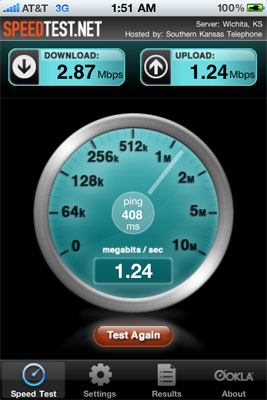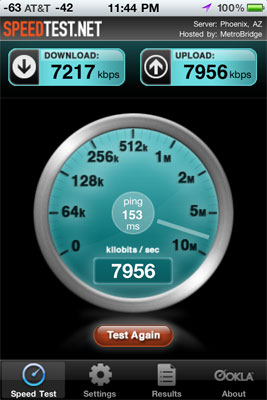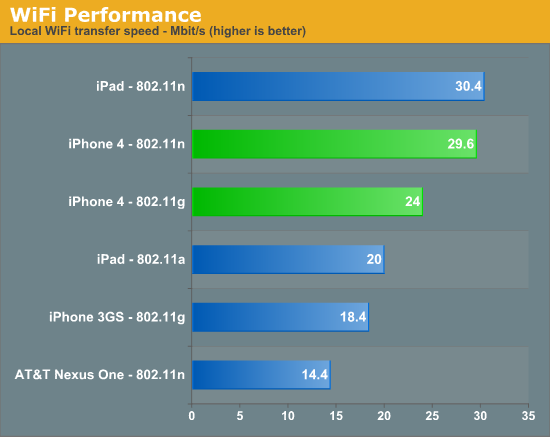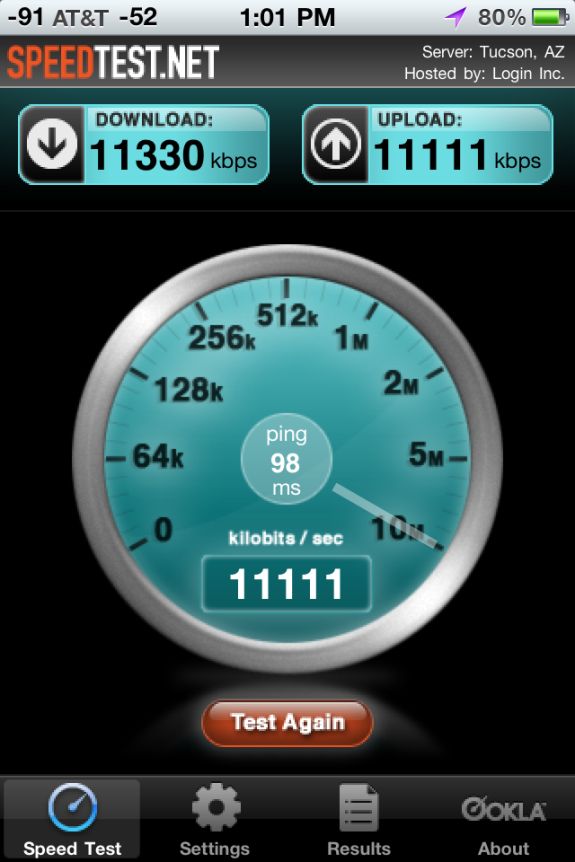Apple's iPhone 4: Thoroughly Reviewed
by Brian Klug & Anand Lal Shimpi on June 30, 2010 4:06 AM EST- Posted in
- Smartphones
- Apple
- iPhone 4
- Gadgets
- Mobile
Network Improvements
The iPhone continues to be an AT&T exclusive in the US. With the iOS 4 upgrades the iPhone 4 supports tethering over Bluetooth or USB. The feature is an extra $20 per month on top of your existing iPhone data plan and it also deducts bandwidth from the 2GB you get with the data plan. It's not a coincidence that AT&T timed the release of its iPhone tethering option with the move away from unlimited data plans. You don't have to give up your existing unlimited data plan if you don't want to, however if you want to enable tethering you have to sign up for the new $25/2GB plan.
I'm not a huge fan of iPhone tethering right now because despite paying for the service and having full signal strength on AT&T, I'm getting horrible transfer rates while trying to upload this article. I had to sign up for airport WiFi to get it live, thanks AT&T. When it does work however, it works well. As you'll see later you can easily get multiple Mbps out of AT&T's network in areas with good coverage. That easily equals the lower end of what you'd see from WiMAX today. As I've mentioned before however, it's really hit or miss with AT&T. The network is either great or totally unusable, while its competitors are generally more consistent but never quite as fast. I'd say that there's a good chance Apple will bring the iPhone to Verizon, it's just a matter of when.
| Cost of Ownership Comparison | |||||
| AT&T iPhone 4 | Sprint EVO 4G | Verizon HTC Droid Incredible | |||
| Cost of Device | $199 w/ 2 year contract | $199 w/ 2 year contract after $100 MIR | $199 w/ 2 year contract | ||
| Plan with 900 Minutes, Unlimited SMS/Data | $104.99/mo, unlimited SMS, 2GB data | $99.99/mo, unlimited SMS, unlimited data, 4G | $109.98/mo, unlimited SMS, unlimited data | ||
| Tethering | + $20/mo | + $29.99/mo | + $25/mo* | ||
| Total Monthly + Tethering | $124.99/mo | $129.98/mo | $134.98/mo | ||
| Total Cost of Ownership over 2 Years | $2718.76 | $2598.76 after $100 MIR | $2838.52 | ||
| Total Cost of Ownership over 2 Years w/ Tethering | $3198.76 | $3318.52 after $100 MIR | $3438.52 | ||
AT&T's plans are actually reasonably priced if you don't go over the data limits. A $15/mo data plan will get you 200MB of transfers per month and $25 will give you 2GB. For users like my parents the 200MB option is great. Even for me personally, 2GB is fine. I tend to peak at 700MB per month, but that's because at the office I'm almost always on my desktop or connected via WiFi. It's unclear how tethering is going to change this for me. Our own Brian Klug on the other hand easily pushes more than 2GB of transfers per month. So AT&T's rate switch is either going to save you a few bucks per month or make you really unhappy.
The iPhone 4 brings HSUPA class 6 for upload speeds of up to 5.76 megabits/s to the platform. This is a 15 fold improvement over the 384 kilobits/s maximum of the iPhone 3G and 3GS, which I routinely see. Not all AT&T markets are updated to HSUPA, and in practice I saw uploads of around 1.5 megabits/s, in line with class 2 or class 3 HSUPA.
Downstream HSDPA speeds remain unchanged from the 3GS, supporting up to 7.2 megabit/s HSDPA. I'm lucky since my market is HSDPA 7.2, as I routinely see speedtests of 5 megabits/s or above very late at night when there isn't very much plant load. I haven't seen any measurable increase in speeds over the 3GS, except in locations with very low signal as noted before.

My fastest iPhone 4 speedtest so far
Even Anand in one of the slowest 3G cities in the US saw significant improvements with the iPhone 4. AT&T's network in general seems to be improving. While the best he'd been able to achieve was around 1Mbps a year ago, these days he can break 2.5Mbps down during the evenings.

iPhone 4 speedtest in Raleigh, NC
WiFi speeds have also improved, as Apple has added 802.11n in the 2.4 GHz band. 5 GHz support remains absent, something which would have likely complicated antenna design even further. Interestingly enough, the BCM4329 WiFi and Bluetooth SoC does contain 802.11a 5 GHz support, the reason it's disabled is again likely due to antenna design constraints. The Broadcom SoC also includes an FM tuner and transmitter, though support for either remains and sadly (given Apple's historical lack of FM radio support) will remain such. Bluetooth 2.1 EDR is there as well.
The iPhone 4 seems to connect at 802.11n rates of 72 megabits/s in best case, far from the maximum without channel bonding of 150 megabits/s. This is still a welcome improvement from the 802.11b/g in the iPhone 3GS, which seemed to never connect above b rates in practice. As an aside, mobile devices using 802.11b rates (modulated using DSSS) are a huge contributing factor to WiFi congestion at conferences - I've even seen DSSS modulated rates (and thus 802.11b devices) explicitly disallowed from connecting to APs at conferences. It's a welcome improvement to see iPhone bringing N support.

A typical WiFi test result
However, even on my 25/4 DOCSIS 3 cable connection, I could only squeeze out a maximum of 8.5 megabits/s down and 8.0 megabits/s up while connected at 72 megabits/s best case. This was using the speedtest.net app to a local test location. I tried with an Airport Extreme (new generation), a WRT600N running DD-WRT, and a WRT54GL-TM running Tomato. All three showed similar results capping out around 8 megabits/s down when I could run tests in excess of 30 megabits down on my desktop. This is probably more of a CPU bottleneck appearing than anything else.
Update:
I thought there was something wrong with my WiFi performance, turns out the iPhone 4 is indeed faster than a palty 8 megabits/s. ;)
There were a number of comments by folks who were able to run speedtest.net and get throughput above 10 or 11 megabits/s. Testing earlier today on a much faster connection, I managed to get something in line with their numbers:
Early today, the folks at DigitalSociety also managed to get much faster WiFi speeds in the neighborhood of 20 megabits/s, way higher than my meager 8 megabits/s. To do so, they loaded an MP3 in safari stored on a local webserver and watched network utilization. I wish I had thought of this, because it's perfect. In the past, the speedtest.net app always used to saturate my connection over WiFi. My only explanation is that the application performs slower over WiFi in iOS 4 than it did in iOS 3, something Anand noted as well. Thanks for all the heads up messages, everyone!
I set up a similar test to DigitalSociety's. I opened an 85 MB PDF stored on my local web server in the browser of each device and watched network utilization using bwm-ng. I tested with an Airport Extreme connected over gigabit to my webserver with no other network utilization. I took the average of 5 runs on the iPad, iPhone 4, iPhone 3GS, and my AT&T Nexus One running Froyo 2.2 (which is 802.11n). The results are much, much more in line with earlier expectations.

The iPhone 4 comes close to but can't quite best the iPad, though the difference is minimal. I did notice that the iPad associates at the same 72 megabits/s connection speed as the iPhone 4. Thankfully, the iPhone 4 easily bests the iPhone 3GS. Finally, although the AT&T Nexus One associates at an 802.11n rate of 65 megabits/s, it's slower than the iPhone 3GS. I have a feeling the device is writing the PDF into flash, whereas the iOS devices are loading it into memory.











270 Comments
View All Comments
Lemurion - Friday, July 2, 2010 - link
I was disappointed that you they only compared the iPhone 4 screen to the 800 by 480 AMOLED screens on some of the Android devices. As far as I know, all those devices use the Pentile system, which reduces the crispness of text.I would have really liked to compare the new Apple screen to the Motorola Droid's 266 PPI screen and see how noticeable the difference there was.
Matt Campbell - Friday, July 2, 2010 - link
Nice investigation work on the signal strength. Just wanted to point out that AnandTech is cited in the Apple iPhone 4 software fix story on CNN today. http://www.cnn.com/2010/TECH/mobile/07/02/apple.ip...Bad Bimr - Friday, July 2, 2010 - link
http://www.cnn DOT com/2010/TECH/mobile/07/02/apple.iphone.apology/index.htmlJust like apple, finally admitting a problem, pleasing the fan boys by saying it will be addressed and doing nothing to fix it. I am so glad I never jumped on the apple bandwagon.
fischerm83 - Friday, July 2, 2010 - link
So i was reading various news articles today and saw that apple finally figured out/admitted to what you guys found out earlier this week...*quote*
Now the company says its engineers have made a "stunning" discovery. Reception is poor and calls may be dropped because not only are people holding the phone wrong, but they also think they have a better signal than they do. In the statement, Apple says that it has made a mistake in the formula that calculates the number of bars that display the signal strength on all of its iPhones.
"We were stunned to find that the formula we use to calculate how many bars of signal strength to display is totally wrong," it said in a statement.
*quote*
Full Article:
http://news.cnet.com/8301-30686_3-20009564-266.htm...
Nice work guys, keep up the amazing work!
anandreader - Friday, July 2, 2010 - link
Brian-I'm confused as to what had to happen to get Fieldtest onto the iphone 4. Understood the bit about jailbreaking the iphone3 but didn't understand how that information got transfered to the 4.
Could you elaborate a bit there?
Per Grenerfors - Friday, July 2, 2010 - link
Thanks for the great review, AnandTech.In countries where 3G coverages isn't spotty like a teenagers face, the whole antenna/at&t/verizon debate is just utterly unnecessary.
Apple is the only brand name in tech today that's recognized by the broader public. Their products therefore make a big splash in the media when they hit the market. But the bigger splash you make, the more mud comes floating up from the bottom. Like people complaining with a spec sheet in hand without ever having seen the device in real life. Or just plain old haters. This is the downside to fame. But I'm sure Apple's laughing all the way to the bank.
Stokestack - Friday, July 2, 2010 - link
A case isn't an acceptable workaround for this. I don't buy a thin phone to bulk it up and junk it up with a cheesy case or add-on of any kind.While I'm not planning on getting an iPhone 4, if I had one and wanted to keep it I'd try to spray a coating onto the antenna band. I'd mask the front & back, the buttons, and any seams, then spray with polyurethane or something. While it would be microscopically thin, there's be no direct contact with skin. And really, that's what you said you expected Apple to have done anyway. Let's see if it would work.
Excellent review. The hack to get the numeric signal strength rocks.
Fulle - Friday, July 2, 2010 - link
Thank you for the review. It was useful to be able to look at something that was detailed, and included facts, good and bad, without a ridiculous amount of bias. It's obvious that Anand likes, or at least really wants to like most Apple products, but it was nice that that didn't get in the way of the review.The new iPhone seems to be an OK device that's on par with new Android smartphones in way of hardware... The screen's got 20% higher pixel density than the Droid, but 50% worse contrast ratio, and worse black quality... Java performance is clearly inferior to a Nexus One, but browsing performance is competitive (I'd say good, but I think all handsets have shit browser performance). Its sleak and thin, but it has no hardware qwerty. The 5MP camera produces low noise, but, the white balance is messed up, making it overall inferior to the camera in a Nexus One or HTC Incredible (or Moto Droid, even, IMHO... screwed up over-saturated colors with bad white balance are a big deal to me). Overall, it's an average device when put up against worthy competition (EVO4G, DroidX, HTC Incredible, Nexus One, or even a Moto Droid).
But, that's before you have to deal with the obvious design flaws. Glass panels on both sides? WTF? Uninsulated external antenna? These aren't minor flaws here.
So, overall I'd say that the new iPhone is inferior to at least 6 Android smartphones.... and at first I grin at that... but then I'm disappointed and mad. Apple has helped make the smartphone market the competitive environment it is today, and when they drop the ball like this, it means that other venders don't have to raise the quality of their devices to compete. It's just fortunate that Android has so many hardware OEMs, like HTC, Samsung, and Motorolla, all competing with each other... or else I'd be afraid the only thing the iPhone4 would push in competition is a higher ppi on the screens.
Lets hope this helps push the Cortex-A9 equipped Android's this winter to include higher resolution in their displays... but, man, I'm disappointed with this device.
tgibbs - Friday, July 2, 2010 - link
Does zero dB represent a standard absolute signal strength or is it an arbitrary reference value that will differ for different phones?navderek - Saturday, July 3, 2010 - link
The signal is actually measured in dBm which means it is a reference to 1mW of power.For example -30dBm = 1000 times less that 1mW = 1uW
1 microwatt does not seem like much, but actually this is a very strong signal for the mobile and you would rarely have that much power arriving at your handset from the tower. In good conditions, close to the tower or serving antenna with minimal obstructions you could expect about -50 to -60 dBm (-60dBm = 1nW (nanowatt). The system is designed to deal with such small signals...this is why I laugh when people are worried about cell tower "radiation" when actually 5 min. in the sun is a bazzillion times more radiation than what's coming out of a tower....cellular towers that is, broadcast radio towers or paging systems are another story!
But I digress...to answer your question simply, zero dBm simple equals 1mW.
Zero dBm signifies that there is no difference in ratio from the reference of 1mW.